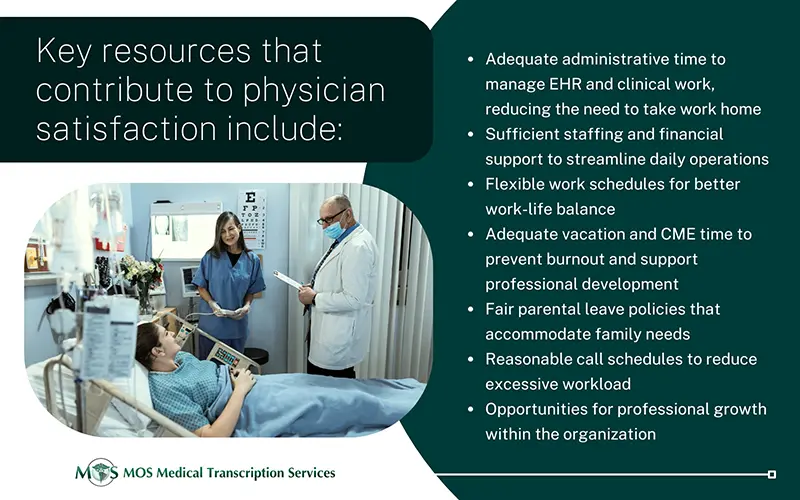
Table of Contents
Although every generation of physicians values both their medical career and personal life, a 2017 American Medical Association (AMA) survey revealed that 92 percent of millennial physicians consider work-life balance a top priority. As a reliable medical transcription company in the US, we understand the importance of work-life balance and strive to contribute by reducing physicians’ workload with accurate and timely medical documentation. With increasing digital accessibility in healthcare, the role of transcription in reducing physician workload has become even more vital, streamlining documentation and freeing up time for patient-focused care. However, despite these efforts, physician burnout rates and job dissatisfaction remain alarmingly high.
Recent data shows that physician job satisfaction dropped to 68% between 2021 and 2022. Additionally, the average workweek increased to 56.7 hours—an additional two hours compared to previous years, according to an exclusive AMA physician satisfaction survey. These extra hours often encroach on personal time, significantly increasing the risk of burnout. This raises an important question: How can physicians effectively manage their work-life balance and improve their overall career satisfaction?
New Generation of Physicians Prioritizes Lifestyle Demands as Much as Work
In the past, it was widely accepted that physicians were expected to work long hours, often at the expense of personal time. However, changing demographics are reshaping this perspective. The new generation of healthcare providers is taking a more thoughtful approach to work-life balance. Millennial doctors are prioritizing lifestyle over work, according to an article in Medical News Today.
Maryam Lustberg, MD, MPH, director of the Breast Center at Smilow Cancer Hospital at Yale New Haven and chief of breast medical oncology at the Yale Cancer Center, highlighted this shift in a Healio Rheumatology article: “The expectation and acceptance that doctors should work all day and all week with no time for themselves and their families has definitely changed. There is a definite recognition of the risk for burnout and that no job is worth the sacrifice of family and health,” she said.
Fewer lifestyle demands may be a key reason why rheumatology is becoming more popular among younger physicians. One major advantage of the specialty is that while physicians may be on call, they can typically handle calls remotely without being required to perform procedures at odd hours.
Research from the AMA and other organizations reveals that more young physicians are opting for employment rather than practice ownership. Many are choosing shift-based emergency medicine and hospitalist roles offering better work-life balance and clearer boundaries between work and personal time.
Additionally, locum tenens positions offer similar benefits, granting physicians greater control over their schedules and freeing them from the administrative burdens of running their own practices.
Factors impacting Physician Work-Life Balance
Physician well-being is influenced by both organizational and individual factors. The burnout epidemic among this generation of physicians often associated with system inefficiencies, administrative burdens and increased regulation and technology requirements. Here are the factors listed by the AMA as causes of physician burnout:
- Conflicting Priorities – Standardization, cost controls, and productivity targets can create conflicts between physicians’ values and expectations, leading to reduced control, flexibility, and autonomy.
- Digital Accessibility Demands – Electronic connectivity has expanded patient communication beyond calls, texts, and emails, with EMR systems enabling direct messaging. Physicians often spend two to three hours or more daily responding to these communications, adding to their workload and physician fatigue of the job.
- Administrative Burdens – The impact of administrative tasks on physician burnout is a critical factor when it comes to work-life balance. Increasing paperwork and regulatory requirements interfere with patient care and drain time and morale from physicians. Many physicians are turning to clinical documentation support solutions to streamline paperwork and regain control of their schedules.
- Work-Life Interference Due to Digitalization – Advances in digital technology have blurred the boundaries between work and personal life, increasing the intrusion of work into nonwork domains.
- Complex Payment Systems – Managing multiple payment models with evolving rules, processes, and incentives adds to physicians’ workload. Expanding risk-sharing contracts in private insurance further increases the burden.
- Medical Record Documentation and Coding Requirements – Compliance with federal and state documentation regulations results in duplicative and time-consuming tasks for physicians.
- Quality Measurement and Reporting – While improving transparency and accountability, the sheer volume of performance measures can be duplicative and not always clinically relevant, increasing the burden on physicians.
- Regulatory Compliance – Meeting HIPAA security requirements for electronic health information protection adds another layer of administrative burden.
Burnout affects physicians across all specialties and practice settings, and it can have a substantial impact on organizational productivity and morale. Increased administrative tasks reduce the time physicians can spend on direct patient care. Furthermore, sleep deprivation among physicians can negatively affect cognitive function, emotional well-being, and overall performance, which has serious consequences.
What Doctors Want
Physicians value meaningful workplace connections and a culture that respects their autonomy and input in decisions affecting their practice. Aline Charabaty, MD, associate professor of clinical medicine at the Johns Hopkins School of Medicine and clinical director of the IBD Center at Johns Hopkins-Sibley Memorial Hospital, emphasizes that healthcare organizations should provide comprehensive administrative and staff support, allowing physicians to focus on delivering high-quality patient care (Healio Rheumatology).

By addressing these needs, healthcare organizations can create a more supportive and fulfilling work environment for physicians, enhancing their work-life balance.
The Way Forward
Addressing work-life balance is crucial to retaining physicians in the profession. According to the Association of American Medical Colleges, 45% of U.S. physicians are over the age of 55. With varying estimates, the U.S. is projected to face a shortage of more than 100,000 physicians by 2030. Some reports suggest this figure could be an underestimate, as thousands of physicians left the profession in 2023. The AMA is dedicated to eliminating physician burnout by identifying its causes and addressing the challenges physicians face, aiming to create a healthier and more sustainable work environment.
To address this growing concern, it is essential to implement strategies that reduce physicians’ workload. The role of medical transcription in reducing physician workload is significant, as it allows doctors to focus more on patient care by clinicaling time-consuming documentation tasks. While accurate and reliable outsourced medical transcription can alleviate the clerical burden, practicing mindfulness and adopting a team-based care model can further reduce burnout by promoting well-being and optimizing workload distribution. Shift-based roles can improve physician work-life harmony. Locum tenens flexibility allows physicians to choose when and where they work, reduce burnout, and explore different practice settings without long-term commitments.
While outsourcing medical transcription can alleviate the clerical burden, practicing mindfulness and adopting a team-based care model can further reduce burnout by promoting well-being and optimizing workload distribution.


